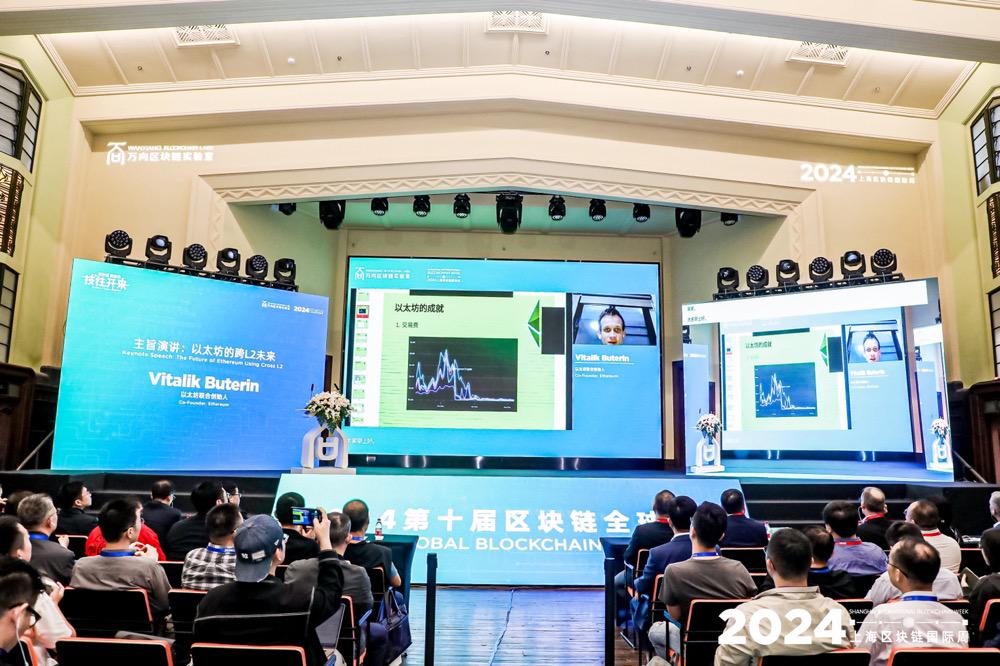On October 17, the 10th Blockchain Global Summit hosted by Wanxiang Blockchain Lab was officially held. Ethereum co-founder Vitalik Buterin reviewed the development path of Ethereum and looked forward to the future in his speech. In the future, Ethereum can reach more than 100,000 TPS through L2, and any transfer from Ethereum chain to other chains can be realized within 2 seconds, and even form a unified user experience. In addition, Ethereums infrastructure is also expanding, and secure links are more important than EVM.

The following is the full text of the speech:
Good morning everyone!
The Ethereum project started in November 2013, the Ethereum Foundation started in 2014, and the volume of Ethereum started in July 2015.
In the first ten years of the Ethereum project, the main goal was to improve the Ethereum technology. If you have listened to the speeches in 2015, 2016, and 2017, you may find that the views I expressed at that time are basically the same as those I express now. In 2022, we merged and moved all from POW to POS. I will also talk about scalability, privacy, zero-knowledge proof technology, and some security issues. In fact, what we are doing now is similar to what we did five or ten years ago. But there has been a lot of progress in the past ten years.
How to see progress?
First of all, there are transaction fees on Ethereum Layer 2. You need to pay a corresponding transaction fee to send a transaction. You may remember that in 2020 and 2021, there was no Layer 2. At that time, Layer 2 was just an idea. The transaction fee on Layer 1 was very high, sometimes $5, sometimes $10, and the highest transaction fee I paid was $800.
In 2022 and 2023, we will start to have some Layer 2. Layer 2 is much cheaper than Layer 1, but it is still not cheap enough.
At that time, there was a big expansion problem. In 2022 and 2023, Layer 2 began to appear. Layer 2 is much cheaper than Layer 1, but it is still not cheap enough. In March of this year, we came up with a very important concept of EIP-4844, which is to put more data space on Layer 2, and use the data space to do some Layer 2 transactions. In this way, the transaction fee becomes very low, from $0.2 to $0.01, which is really a big difference. There are many applications. If you tell users that you only need to pay $0.4 to do anything on the chain, developers think this is completely unacceptable. If the transaction fee can be reduced to $0.01, it will be a completely different matter.
In fact, there are many AGI applications that can be made now. Because when there are a lot of transactions in the application, people are unwilling to pay $0.2, but for non-TURBO applications, users are used to free, and $0.01 can be said to be very small. Developers can pay these fees to users. This is the success of Ethereum in social networking. By solving related problems, we have reduced the transaction fee problem.
Second, transaction confirmation speed.
That is, after you send a transaction, how long does it take for the transaction to be confirmed in the blockchain. As we all know, the average block time of Bitcoin is 10 minutes, sometimes 65 minutes, sometimes 30 minutes, and sometimes 70 minutes. The confirmation time is very unstable. Ethereums block time was 17 seconds at the beginning, then it became 4 seconds, and then 12 seconds. But we have a problem. The assumption of transaction fee Gas has efficiency problems. When you send a transaction, the transaction fee is very high. The transaction fee is too low, and you suddenly find that you have to wait for a long time, maybe 5 minutes or 30 minutes, before your transaction can be put into a block. But in 2021, we made a 1559 protocol. After 1559, the waiting time for users is very short. In fact, most of the time, after you send a transaction, your transaction will be found in the response block, and your transaction will be confirmed. This may be 90% of the time. In the other 10%, you still have to wait for the corresponding block. But the time you need to wait is very low. This is Layer 2.
In 2023 and 2024, our initial goal is to solve the problem of expansion and make some cheaper transactions, that is, send your transaction to the Layer 2 node, and the node will directly send you a message to confirm and put your transaction in the next block. If you are willing to trust the Layer 2 node, you can know that your transaction has been confirmed within 1 second or 0.5 seconds. This is also a very important part.
Third, the user experience of each application.
You can see on the left, it is an interface based on Ethereum in 2015, called EtherTweet. This is a very simple thing, obviously a very early thing. If you are not a blockchain user, you don’t know what Ethereum means. On the right, you can see Firefly (Farcaster+twitter+Lens Client), which is a client they made. As you know, Farcaster is the largest social based on Ethereum.
In this Firefly interface, you will know that the customer quality is very good. Why did I write three? You may have seen some information that in some countries, including Argentina and Turkey, more than 10% of the national population holds digital currency. I found that there are really many digital currency users in these places, but there is a problem. They are not blockchain users. They use their digital currency through some centralized services. Why? It is because the transaction of some centralized services, that is, from one account to another, is free and does not require time. And the interface is also very well done.
If we want these users, not just digital currency users but also blockchain users, to truly gain the trustless nature of blockchain, we will have truly solved the problem of blockchain.
There are still many improvements, that is, the topic of smart accounts and account abstraction. We have made a lot of progress this year.
Sa This e This is A well-known multi-signature wallet, now used by many people. ZKEmail, if you have an email account, you can use Ethereums smart contract, which is done through zero-knowledge proof.
There are also some issues with account abstraction.
Then there is the topic of zero-knowledge proof. I have been talking about zero-knowledge proof since 2015. The technology of zero-knowledge proof has developed a lot. In 2016, a Zcash transaction was issued, which took 90 seconds or 2 minutes on a computer, and it was completely impossible on a mobile phone. Now, it takes only 1 second to issue a protocol on a mobile phone, so the progress is huge. For example, Zupass is based on zero-knowledge proof, such as identity; Rarimo uses zero-knowledge proof to prove the information in your passport.
Then the experience of wallet users has also been greatly improved.
So in the past ten years, there have been many technological advances, which have brought many advantages to users. So five years ago, we could do some early things, but it was impossible to become a blockchain application for mainstream users, but now it is possible.
So what is our main problem now? For Ethereum, there is a very important issue, that is, everyone feels that the Ethereum ecosystem is like a 30-year-old person. What we should do is to unify the Ethereum ecosystem.
If you have coins, and your coins are on other chains, and you want to send your coins to other chains, the process is very complicated. A user needs to go to a special website, and the whole process is very complicated, and it is easy to make mistakes in this process. If you want to send a coin, if you don’t choose the right network, you will send it wrong. So now we have many challenges, mainly in this.
Another important topic I have is chain-specific addresses.
There is also the ERC-7683 protocol, which is a protocol for trading coins. You can use this protocol to trade your coins for coins on another chain. If we combine these two, the process of issuing coins will be very simple.
Another topic is light client. Now most users use an RPS and some nodes if they want to see something. This RDC process is based on trust and is centralized. There is a project that uses Helios as a light client for 1, without L2. If you have an L2, you can put a contract on the Ethereum chain, and L2 can nail its own merkle proof function in the Bridge Street contract, which can be used as a general light client. In fact, we have many solutions to solve many problems.
Another very important topic is the development of zero-knowledge proof. In the past five years, zero-knowledge proof has evolved from a theoretical thing to something that many people can use. So there are many on-chain applications and some off-chain applications for zero-knowledge proof. The biggest circle is very interesting. Crypto is not moving forward. So now Crypto. I think if non-financial applications want to succeed, they need to use a part on the blockchain and a large part off the chain. Because non-financial applications require a lot more Gas than financial applications. How many transactions do you send every day, how many payments are made, etc., what non-financial applications do you do every day, for example, you may post something on a social media. So I don’t think blockchain can handle everything.
Let’s talk about the future of Ethereum.
First, use L2 to achieve more than 100,000 TPS. A Google article says that this goal can be achieved through some methods.
Second, transfers from any chain on Ethereum to any other chain can be made within 2 seconds.
Third, unified user experience, which is very important.
Fourth, it is not just EVM: the security link is more important than EVM. Ethereums technology is expanding. Ethereum has EVM and non-EVM things. For Ethereum, the security link, that is, whether your chain is protected by Ethereum, is more important than EVM. This is the technical direction we still need to work on.
There are a lot of things you can start doing now. So if you have some ideas that you didnt succeed with before, I think its time to try them now. Because with todays technology, things that didnt work before, now (maybe) can work.










